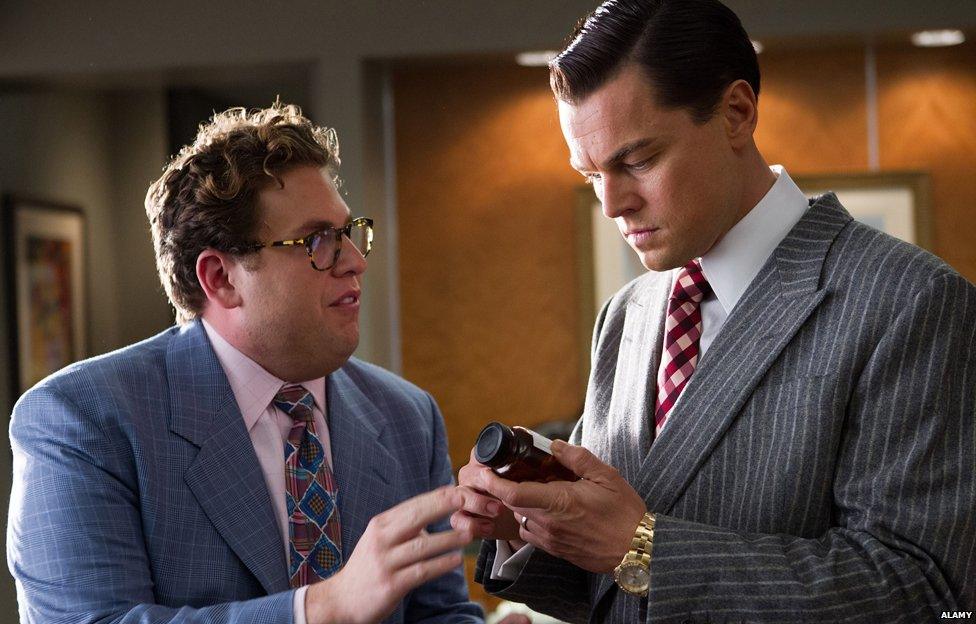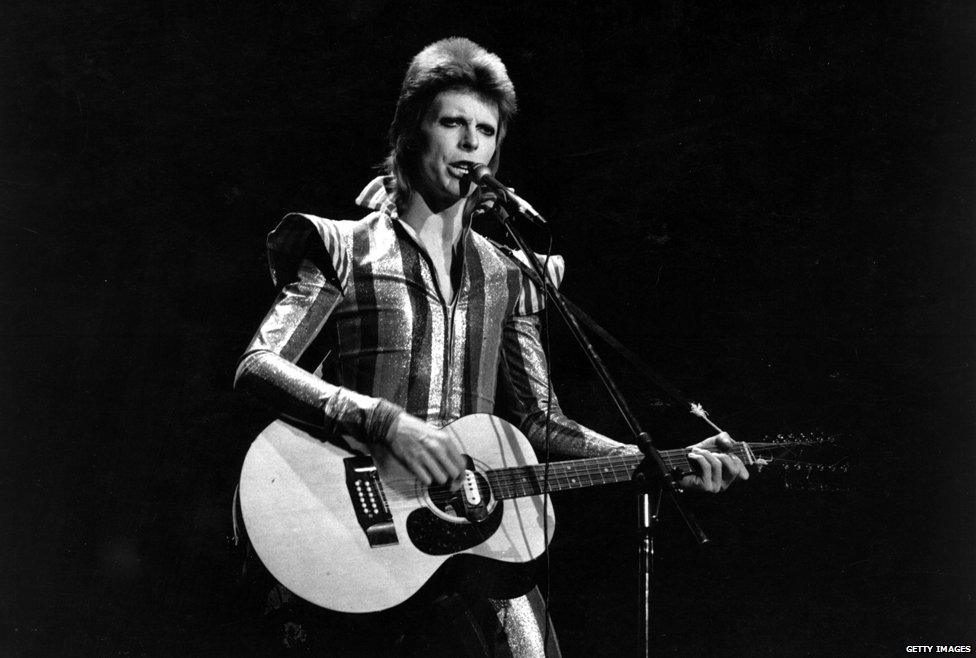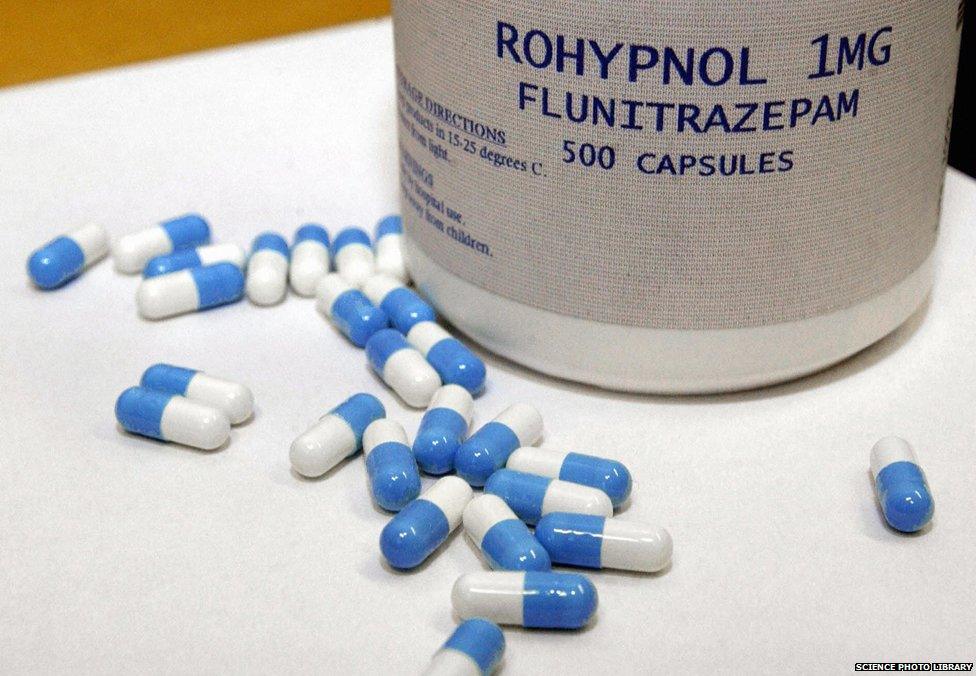The rise and fall of Quaaludes
- Published

Quaalude was popular in the US in the 1970s. Now, the drug is back in the headlines after the revelation that comedian Bill Cosby admitted getting them to give to women he wanted to have sex with.
The admission was made in 2005, but the court papers were only released this week.
They refer back to a period when Quaalude was taken as a recreational drug - so much so that the sedative pill has been banned in the US for over 30 years.
Anyone who has seen Leonardo DiCaprio's depiction of a Quaalude binge in Martin Scorsese's The Wolf of Wall Street - in which he can barely speak, can't walk and certainly can't drive - may well wonder what why anyone would take it intentionally.
Quaalude is a tradename for methaqualone, which was first synthesised in 1951 in India. Germany and Japan were the first big markets, where the drug racked up an extensive record of addiction and abuse. In the UK it was known as Mandrax, a name still used in South Africa.

Law enforcement officers confiscating Mandrax pills in South Africa
By the time it reached the US in the 1960s, it was being used to treat insomnia and anxiety. However, it didn't take long for the drug's potent features to be misused.
"Doctors were essentially giving them out like candy," says Justin Gass, author of a book about the drug. "It was very easy to obtain Quaaludes in the mid-late 1970s and early 1980s."
People could buy them in semi-legal "stress clinics" without needing to visit a GP. They were pseudo-medical centres that would hand out the maximum legal prescription. These tactics would often be the clinics' eventual downfall, says David Herzberg, professor of history at the University at Buffalo.
At its height during the 1970s, Quaalude could be found across the US and earned the nickname "disco biscuits".
"America in the 1950s and 1960s was having a sedative boom," Herzberg explains, "so there was this wonderful market for them." As the barbiturates popular in the 1950s became stigmatised, drug companies introduced newer sedatives such as Librium and Valium, which claimed to be significantly different.
Quaalude was part of that new wave. And although unpatented, meaning any pharmaceutical company could produce methaqualone, Quaalude was the name that stuck.
Herzberg says people found it more pleasant to take than other sedatives.
The main consumers - at least recreationally - were young people. "[They'd] decided that all the drugs their parents took were these soul-killing corporate things that would turn you into a conformist robot," Herzberg says.
Musicians sang about them. David Bowie's Time references "Quaaludes and red wine" while Frank Zappa speaks of "Quaalude moonlight"

David Bowie sang about Quaaludes
Quaalude had a novelty but also a distinct selling point. "It got the reputation of relaxing people so that they can have freer sex," Herzberg says, which made them catch on across college campuses. Bay City Rollers lead singer Les McKeown has said he was raped, external by another man at the height of their fame after being given Quaaludes.
It provides users with a "really powerful high", says Gass, now a professor of neurosciences at the Medical University of South Carolina. It takes just 30 minutes to start having an effect, which can last up to six hours.
But it could be dangerous, particularly when mixed with alcohol, as it often was. "People would lie down to go to sleep and just not wake up," says Gass. "That was quite common."
In the UK, methaqualone was sold under the name Mandrax and became popular too. Rolling Stones guitarist Keith Richards admitted possessing the drug in October 1973.
Earlier that year, a tribunal heard testimony that a Mandrax addict had taken between 10 and 12 tablets before driving a car into a bus, killing two and injuring four others, the Times reported. "A further trend of misuse is mixing Mandrax and alcohol, with disastrous results," said a Church of Scotland committee report on moral welfare.
They increasingly drew negative attention. "There's no doubt we've lost a considerable amount of business because of this substitution of the trade name for the generic name," Elliot Fisher, lawyer for Lemmon, who made the drug, told Associated Press in 1981. He said he was writing up to 50 letters a week to newspapers and police forces complaining about the use of the word "Quaalude" and finding many respondents were surprised it was a trademark.
Regulators eventually stepped in. By 1984, the drug was listed as Schedule I in the US and a Class B drug in the UK, which makes its production and distribution illegal altogether.

Rohypnol, a drug commonly cited in rape cases, which is part of the Valium family, has sometimes been referred to as the Quaaludes of the 1990s. It has many of the same effects, says Gass. It's quick to work, erases memory and is a muscle relaxant.
Methaqualone is no longer legitimately manufactured but it's still possible to find people claiming to sell Quaaludes on the streets, explains Gass.
"But they are generally nothing more than a combination of different barbiturates which they hope would create the same effect but it certainly does not."

More from the Magazine

An undercover operation smashed one of the most extraordinary drug rings the world has ever seen and changed British policing forever. What was Operation Julie?

Subscribe to the BBC News Magazine's email newsletter, external to get articles sent to your inbox.